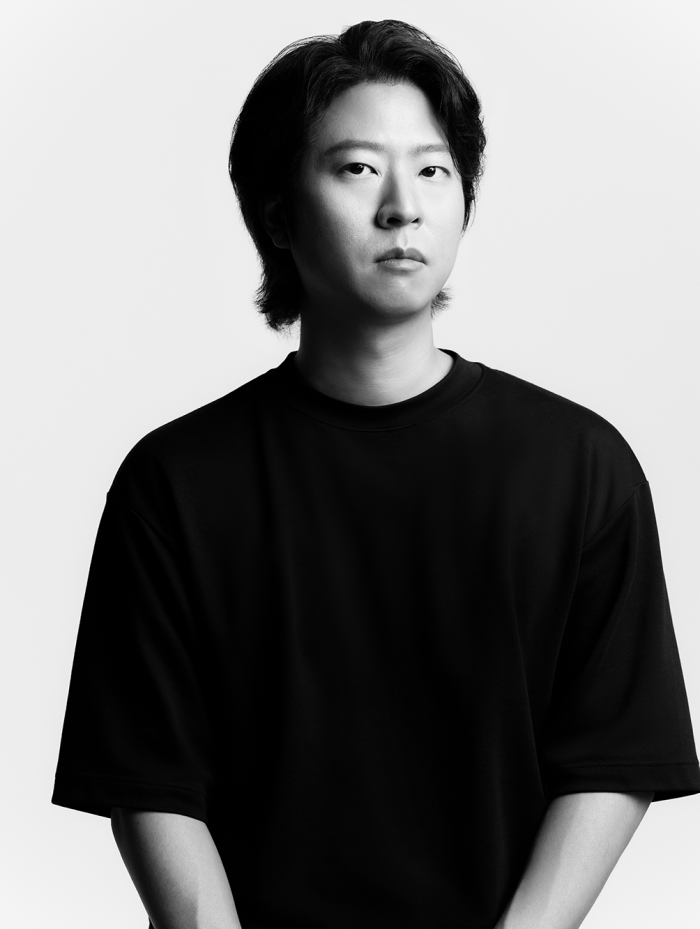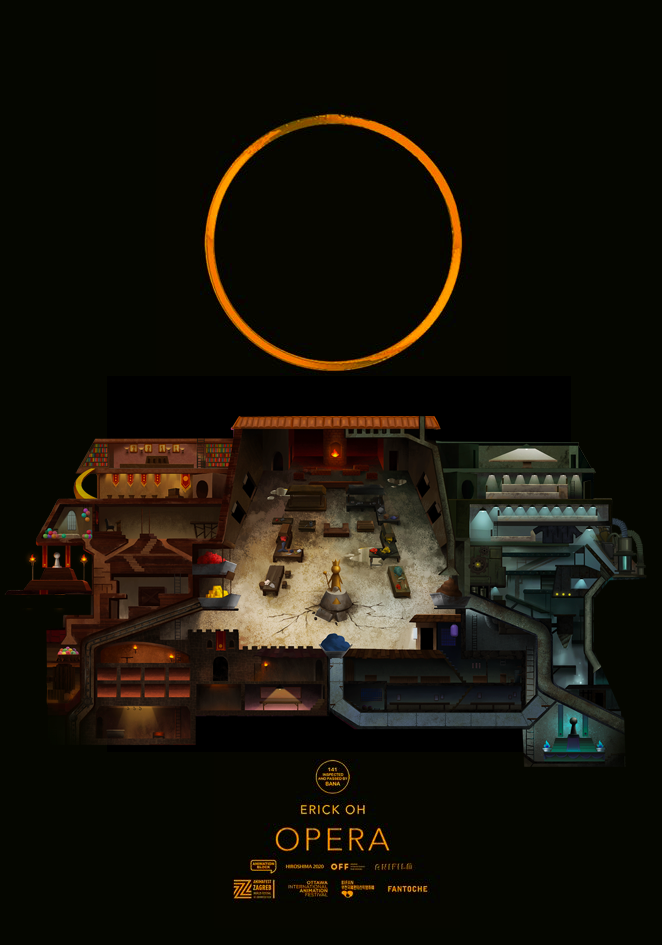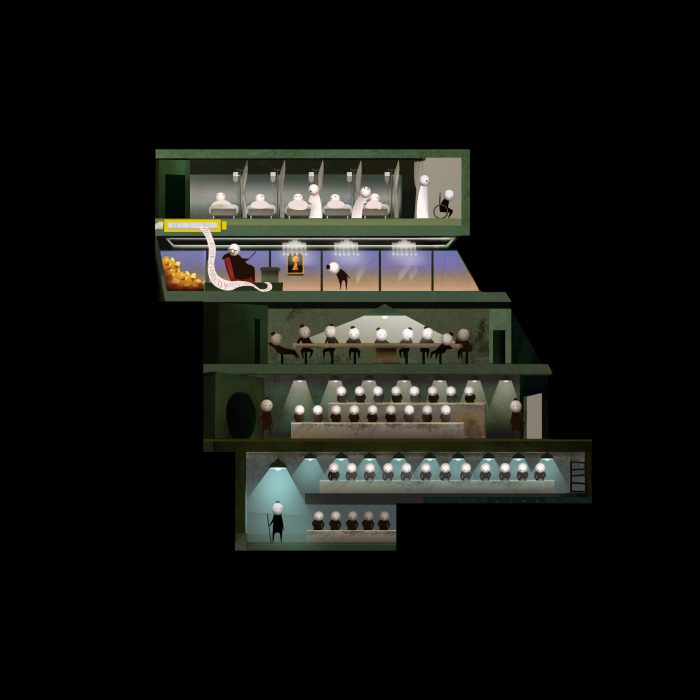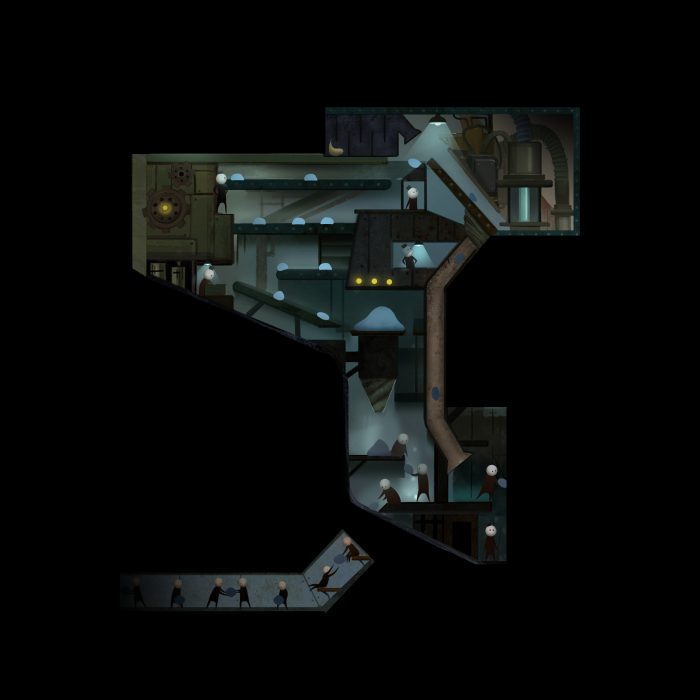Published Date: 08-04-21
By Justin Sanders
Every year, one filmmaker takes home the CreativeFuture Innovation Award from the Slamdance Film Festival. This year’s winner is Erick Oh, whose powerful animated short Opera uses a single, massive canvas and an army of faceless, lemming-like drones to convey the full sweep of human society and history in all its beauty, absurdity, and horror.
Moving up and down a static, triangle-shaped backdrop that teems with tiny, anonymous figures engaged in activities ranging from farming to torture, Opera is a riveting, unforgettable viewing experience. Which is why we were not remotely surprised when, after receiving our own special prize at Slamdance, Opera was nominated for another little honor you might have heard of called the Academy Award® – in the Animated Short Film category.
Unfortunately, our grand visions of the two statues, CreativeFuture and Oscar®, sitting side by side on Oh’s shelf, did not come to fruition. Opera did not take home the Oscar®, but Oh was hardly disappointed. He calls the whole experience “like a dream” and marvels at the “roller coaster” ride of a film that was originally intended to be mounted as an art exhibition in gallery spaces. In any case, he is too busy working to reflect on the experience for long. The former Pixar animator’s VR experience, Namoo, is coming to Oculus platforms later this year.
Oh spoke with us from his home studio in Los Angeles, in a wide-ranging conversation that covered, among other things, the recent global strife that inspired Opera, his career beginnings as an intern at Pixar, and what it was like to attend the Oscar® ceremony during a pandemic.

Justin Sanders: Erick, congrats again on the Oscar® nomination for Opera. It’s a truly stunning achievement. I would have assumed the Academy Awards® are kind of the pinnacle in terms of a film’s festival run, but your publicity team informs me that even post-Oscars®, Opera is still making the rounds in film fests.
Erick Oh: Not only film festivals but exhibition spaces, too. It was actually designed to be an art piece in a gallery space and that’s still our goal even after all this craziness.
JS: That’s interesting. What compelled you to design the film for exhibition in a gallery space as opposed to where one would normally envision a film playing i.e., a movie screen?
EO: I designed both a theatrical and gallery version together. When I was making Opera, I started to think I couldn’t tell this story in a traditional linear narrative because I’m here to talk about, you know, history and human society. The scope of what I wanted to say led me to think that maybe this could be an art piece and not just a traditional short film. But I still always wanted to show it as a film as well, so that’s why we made both versions.
JS: When you say you “designed” both versions of Opera, what do you mean? Does it present differently in a gallery space than it does in a theater?
EO: Well actually, there’s not much difference. The goal is to provide the same experience whether you’re in the theater or you’re in a physical space. But different environments have different strengths and personalities, so I wanted to reflect those in the different versions.
So, for example, in the exhibition version, there is no camera movement – it is just a static pyramid that is supposed to be projected on a gigantic wall. So, a viewer would ideally walk into, say, a warehouse and come across this incredible, crazy sight extending up to the ceiling. The exhibition version is also a perfect loop, meaning the end of daytime in the film syncs up with the beginning of nighttime, so it can be repeated endlessly for as long as the given space is open. And then we can also play around with the audio and use the location of the speakers to make it a more immersive experience in a physical space.
On the other hand, in the theatrical version, you just sit down and watch it and then you’re done – so, it has a bit of camera movement and we added music to give it a bit more of an emotional arc.
JS: It’s amazing that what originated in your mind as an art gallery piece eventually found its way to an Academy Award® nomination in the Animated Short Film category. How did that journey unfold?
EO: [Laughs] First off, the Oscars® were definitely not part of our plan. By August of last year, we were, as I said, pursuing both film festivals and exhibitions. But because of the pandemic, all of the exhibition venues pushed us or cancelled us. What’s more, film festivals all went online, which was kind of challenging because Opera, whether it’s in a gallery or on a screen, is a piece that needs a big space. It’s not a piece you want to watch on a 15-inch monitor, you know?
I was really upset about this, so I kind of rejected some festivals or put them off until next year – but I soon realized that many of them may not come back in the near future. So, we decided to just roll with it and started more aggressively submitting to the fests. And suddenly [laughs] we were Oscar®-qualified and all we could say was, “What the hell is going on?”
That’s when everything changed for us and it’s just been a roller coaster ride since then.

JS: What was is it like going to the Oscars® during a pandemic?
EO: This was actually my second time nominated for the Oscars®. [Ed: the first time was as supervising animator for the 2014 animated short, The Dam Keeper.] Normally it’s like a marketplace – there are thousands of people and you know nobody there, and there are all these celebrities and stars. This time, it was just the nominees and their plus-ones, so it was an intimate, small party and it was really fun. I went there with my wife, and I was already friends with a lot of the animation nominees, so I didn’t feel so alone there. We were having a great time. It still feels like a dream looking back!
JS: What inspired you to make a short film that, as Opera’s tagline suggest, sets out to do nothing less than chronicle “our society and history, which is filled with beauty and absurdity”?
EO: I’ve been in the animation industry for about 10 years and I’ve always had this vision to try something new and to challenge ourselves as creators and also challenge the audience. Animation doesn’t have to be the way we’re all familiar with – I wanted to push the medium.
That was in the back of my mind in the summer of 2017, a tough time for everybody, politically and otherwise. The whole nation kind of split into two polar opposite groups, but it wasn’t just America either, you know? That was the same year where, in Korea, millions of people gathered in central Seoul and after months of riots and protests, our President got impeached.
For me, as a Korean-American, seeing my two homes so troubled was a wakeup call. I thought, “as an artist, as a filmmaker, I need to document this. The racism, the gender issues, the environmental destruction, the terrorism… all of it.” That was really the origin and genesis of our project, to talk about history and our society in all its joy, happiness, sadness, and terror – and how we are all in it together, living this life. And the message inspired the medium, I guess.
JS: How did the message inspire the medium? How did your goal to essentially chronicle the sweep of human civilization manifest in the film’s design – a static pyramid backdrop teeming with stories enacted by what are essentially stick figures?
EO: Coming up with that triangular shape was not difficult. I wanted a simple iconic shape as my canvas and in a way, I had to use a series of triangles because I’m trying to tell these stories of the different classes and sections of our society.
So, the triangle shape was one of the first things I came up with, and then it was a matter of trying to populate it with something that is both reflective of how I observe the world and that could resonate with a lot of people. Some of the aesthetics inside the triangle were things I was already doing in my previous shorts. I’ve actually been using the black and white stick-figure characters for many years. I made an earlier film using those characters and I do a lot of watercolors with them as well. I see them as avatars that can be used to tell a variety of different stories about the human condition.

JS: It’s an interesting juxtaposition because on the one hand, you have crafted this massively complex narrative juggernaut, and on the other hand, the delivery mechanism – an army of faceless drones – could not be simpler. Why do you think the stick figures are such effective vessels for communicating Opera’s themes?
EO: I didn’t feel like this was a character-driven story. I’m here to talk about the overall picture – what’s happening for everyone, all at once. So, I didn’t think it was important to showcase individuality in the figures. I went with a simple, basic design concept so that we don’t get distracted by facial expressions or personalities. We can just step back and look at our own reflection through these guys. They are like the Mini-Mes of who we are.
JS: As a writer myself, I’m fascinated by how you have found a way to weave together all of these narratives and stories in a way that is somehow lucid. It’s not just a feat of design and animation but of storytelling – how did you write the script for Opera? Or did you write a script?
EO: There was a writing component for sure but it was all mixed up because I knew the outcome would be so different from any other project I had done. It’s not a linear narrative film. There is no dialogue and no narrative through-line – and yet there are many narratives and stories if you look inside. There are about 24 different “sections” in the world of Opera, but that doesn’t mean there are only 24 stories – because these sections share and create new stories when working together.
Because I’m such a visual person, I really jumped into drawing sketches and thumbnails in the brainstorming phrase. It wasn’t like most films where first you write and then you conceive of visuals – it was kind of all at once. [Laughs] It would be difficult to even show my early sketches because they are a mixture of doodles and then some scribbles over here and some writings over there, and that’s how it went.
Eventually, I finalized one single drawing that was almost like a storyboard. It was one singular image of the entire pyramid structure with notes and sketches detailing what was happening in each section.
JS: That must have been some drawing. How big was it?
EO: [Laughs] It’s like 8,000 by 8,000 pixels in a Photoshop file.
JS: From farming to romance to torture, there are too many threads to cover here in detail, but one particular symbol in the film felt very resonant – a key that hangs in the air at the very bottom of the triangle. I found that image so powerful and poetic, but I’m curious how you interpret its meaning?
EO: Basically, the key is always there. It doesn’t go anywhere and nobody does anything with it. Then there’s a lock at the very top of the pyramid and they are located as far as possible from each other. And the sad reality is they will never meet. The key represents answers to all the questions in the world, and the keyhole is all the answers in the world. Those symbols are a way for me to explore this question: Do all the answers we have to all the world’s questions really match? Are they really the correct answers? All the things we think we know, can they be re-thought?
JS: You have said in other interviews that this was a labor of love for a lot of people, done in between other projects over the span of four years. Give us a little window into the animation process and how this all came together on the technical side.
EO: Opera was such a unique production because it was something I was doing as a side project while I had a day job. The first half of production was, like you said, a group of friends getting together and sacrificing their nights and weekends to do this. And because I was at Pixar, most of them were Pixar animators.
JS: [Laughs] Not a bad group of friends to have on board a passion project!
EO: [Laughs] Thankfully, they were really fascinated with the project and they were having a lot of fun, too, because it’s so different from what Pixar does normally. People are having sex, people are killing each other – [laughs] they were having a bit of fun animating all that.
Things started getting really visually complicated about halfway through the project. But then we were finally able to get some funding, from a Korean production company that is a passionate, open-minded group of artists. With their help, we were able to smoothly finish the rest of the production.

JS: Sorry if this question is too simplistic, but what is your day job, Erick? You’re an animator and a filmmaker of course, but how does that work manifest when you’re not making Oscar®-nominated shorts?
EO: For a long time, my job was just animation and storyboarding but for the past couple of years I’ve been fortunate enough to be a full-time freelance director. So, while I was finishing Opera, my day job was directing a VR piece that recently premiered at the Tribeca Festival. It’s a very personal story called Namoo, which means “tree” in Korean, that I was inspired to tell after I lost my grandfather. In it, we follow just one character all the way from birth to his later chapters in life. Like Opera, we did two versions, so Namoo came out as a VR piece in January and then we spent another three or four months transferring everything into a cinematic world so that people can watch it as a short film.
JS: Growing up in Korea, how did you decide to become an animator?
EO: I just knew from a very young age. Every kid likes animation, cartoons, and comics – but I was the little boy who was saying, “I want to be a Disney animator when I grow up.” I remember watching The Lion King on DVD, and there is a behind-the-scenes video where it shows a drawing coming to life, and that just blew my mind. I was like, “I want to do that. I want to be there.”
JS: Everyone has childhood dreams, though – you actually fulfilled yours. You became a Pixar animator! That’s the animation equivalent of an athlete making it to the NBA or Major League Baseball.
EO: When I got the job at Pixar, that was maybe the happiest moment of my entire life. [Laughs] I think I was even happier than when we got nominated for an Oscar®. Getting hired by them is still like a dream to me. It was so surreal. You can’t imagine how happy I was.
JS: How did you first get hired there?
EO: Like many students, I submitted my portfolio during my second year of college and wound up getting an internship at Pixar. The internship was about three months long and it was like a bootcamp – there were many interns there but only a few got hired at the end of it. [Laughs] It was like a survival reality show. It was extremely hard and I didn’t get hired, and, by the end of it, I was so tired I was almost relieved to have a break. But then two months later, they asked if I wanted to come back and I said, “Hell yeah!” [Laughs] So that’s how I became part of Pixar.
JS: What advice would you have for young artists who might share that dream of one day working for Pixar or another animation company?
EO: It’s advice that I also remind myself of a lot – at the end of the day, you are a storyteller. The message and ideas you convey through your art is important and everything will be designed and developed around them. Of course, craft and technique are important, too, but what’s more important is how you bring yourself into the work. When we’re hiring, we get tons of portfolios, but I am most drawn to people with distinct and compelling voices.
If helps to be an incredible artist and have a great skillset, but the candidates we like best are the ones who have something to say.



